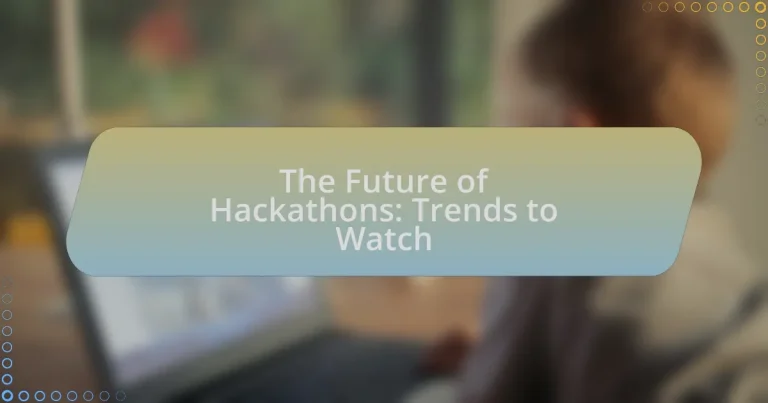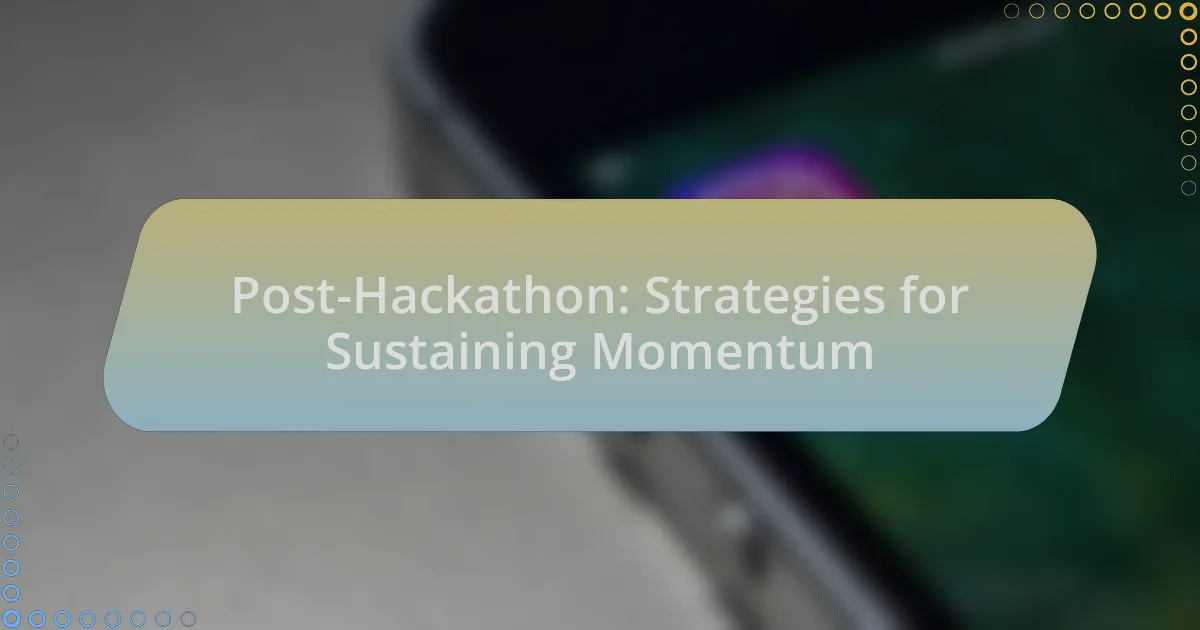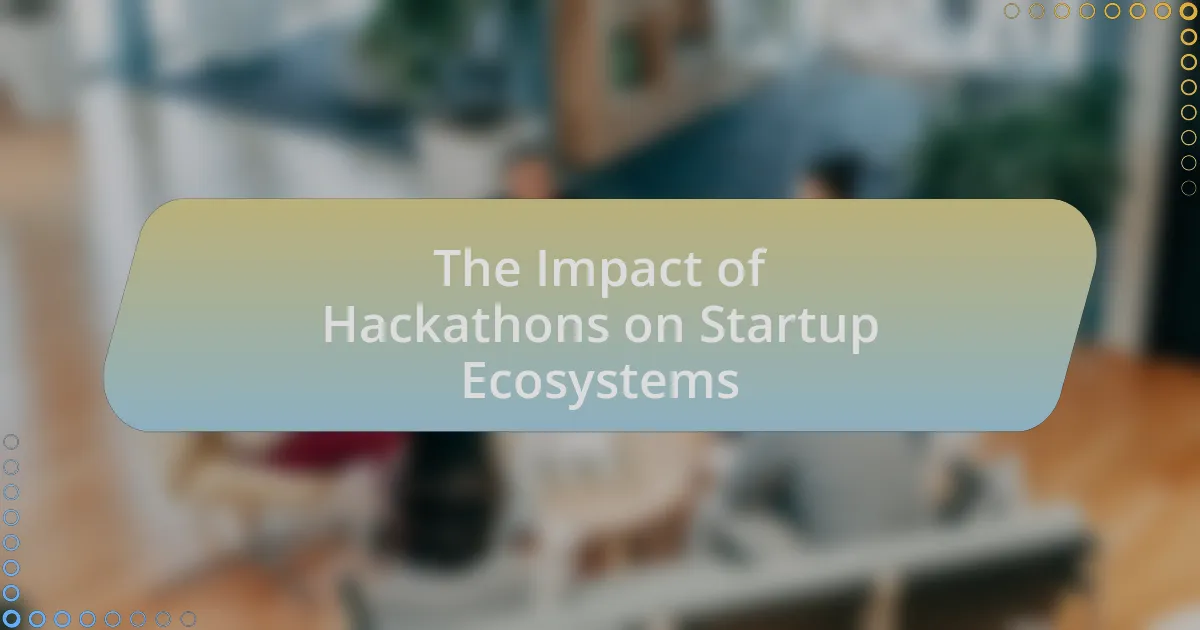The article “The Future of Hackathons: Trends to Watch” examines the evolving landscape of hackathons, highlighting key trends such as sustainability, remote participation, and diversity and inclusion. It discusses how technological advancements, particularly in artificial intelligence and blockchain, are shaping hackathon themes and participant demographics. The article also explores the impact of hybrid formats on engagement and collaboration, as well as the emerging focus on social responsibility and innovative topics like mental health and sustainability. Additionally, it addresses the role of hackathons in fostering startup ecosystems and corporate partnerships, while providing best practices for organizers to enhance participant experience and project success.
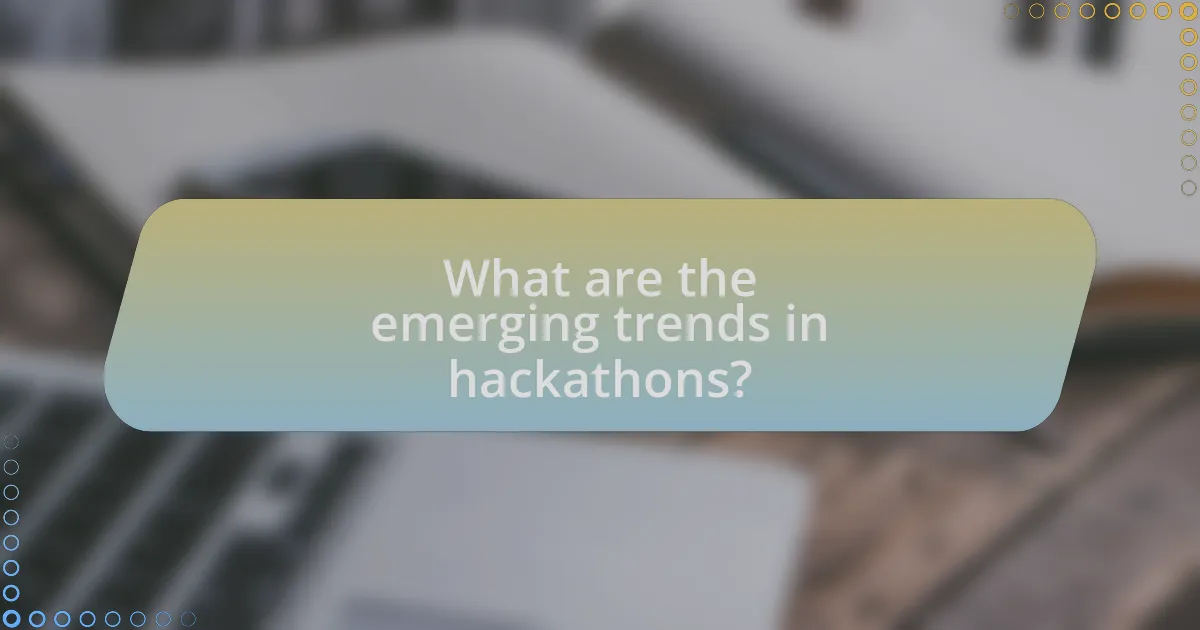
What are the emerging trends in hackathons?
Emerging trends in hackathons include a focus on sustainability, remote participation, and diversity and inclusion. Sustainability is becoming a priority as organizers encourage projects that address environmental challenges, reflecting a growing awareness of climate issues. Remote participation has gained traction, especially post-pandemic, allowing global collaboration and increasing accessibility for participants. Additionally, there is a strong emphasis on diversity and inclusion, with initiatives aimed at attracting underrepresented groups in tech, which enhances creativity and innovation. These trends are supported by data showing increased participation rates and project quality in diverse and remote settings, indicating a shift in how hackathons are structured and executed.
How are technology advancements shaping hackathons?
Technology advancements are significantly shaping hackathons by enhancing collaboration, accessibility, and innovation. The integration of cloud computing allows participants to access powerful resources and tools remotely, facilitating teamwork across geographical boundaries. Additionally, advancements in artificial intelligence and machine learning enable developers to create more sophisticated applications in shorter timeframes, increasing the overall productivity of hackathon teams. Furthermore, the rise of online platforms for hosting virtual hackathons has democratized participation, allowing a diverse range of individuals to contribute their skills and ideas. According to a report by TechCrunch, the number of virtual hackathons increased by over 200% during the pandemic, highlighting the impact of technology on expanding participation and engagement in these events.
What role does artificial intelligence play in hackathon development?
Artificial intelligence plays a crucial role in hackathon development by enhancing creativity, automating tasks, and providing data-driven insights. AI tools assist participants in generating innovative ideas, optimizing coding processes, and analyzing user needs through data analytics. For instance, platforms like GitHub Copilot utilize AI to suggest code snippets, significantly speeding up development time. Additionally, AI can facilitate team collaboration by matching participants with complementary skills, thus improving project outcomes. The integration of AI in hackathons not only streamlines the development process but also fosters a more dynamic and efficient environment for innovation.
How is blockchain technology influencing hackathon themes?
Blockchain technology is significantly influencing hackathon themes by driving a focus on decentralized applications, smart contracts, and cryptocurrency solutions. This shift is evident as hackathons increasingly feature challenges that encourage participants to develop innovative projects utilizing blockchain for transparency, security, and efficiency. For instance, the rise of decentralized finance (DeFi) has led to hackathons centered around creating financial applications that operate without intermediaries, showcasing the technology’s potential to disrupt traditional finance. Additionally, the integration of non-fungible tokens (NFTs) in hackathons highlights the creative applications of blockchain in digital art and ownership verification, further emphasizing its impact on emerging themes in the hackathon landscape.
What changes are occurring in participant demographics?
Participant demographics in hackathons are increasingly diversifying, with a notable rise in female and underrepresented minority participants. Recent studies indicate that female participation has grown from approximately 20% to over 40% in many events, reflecting a concerted effort to promote inclusivity. Additionally, organizations are actively targeting underrepresented groups, resulting in a broader age range and varied educational backgrounds among participants. This shift is supported by initiatives from tech companies and educational institutions aimed at fostering diversity in tech fields, which has led to a more balanced representation in hackathon settings.
How are diversity and inclusion initiatives impacting hackathon participation?
Diversity and inclusion initiatives are significantly increasing hackathon participation by creating more welcoming environments for underrepresented groups. These initiatives often include targeted outreach, mentorship programs, and inclusive policies that encourage participation from women, minorities, and individuals with disabilities. For instance, a study by the Kapor Center for Social Impact found that diverse teams are more innovative and effective, leading to a greater emphasis on inclusivity in hackathon settings. As a result, hackathons that prioritize diversity see higher registration numbers and more diverse project outcomes, ultimately enriching the overall experience and fostering a culture of collaboration and creativity.
What age groups are increasingly participating in hackathons?
Individuals aged 18 to 24 are increasingly participating in hackathons. This trend is supported by data indicating that college students and recent graduates are the primary demographic engaging in these events, driven by the desire to enhance their skills and network with industry professionals. Additionally, reports show that participation from younger professionals, particularly those aged 25 to 34, is also on the rise, reflecting a growing interest in innovation and technology among these age groups.
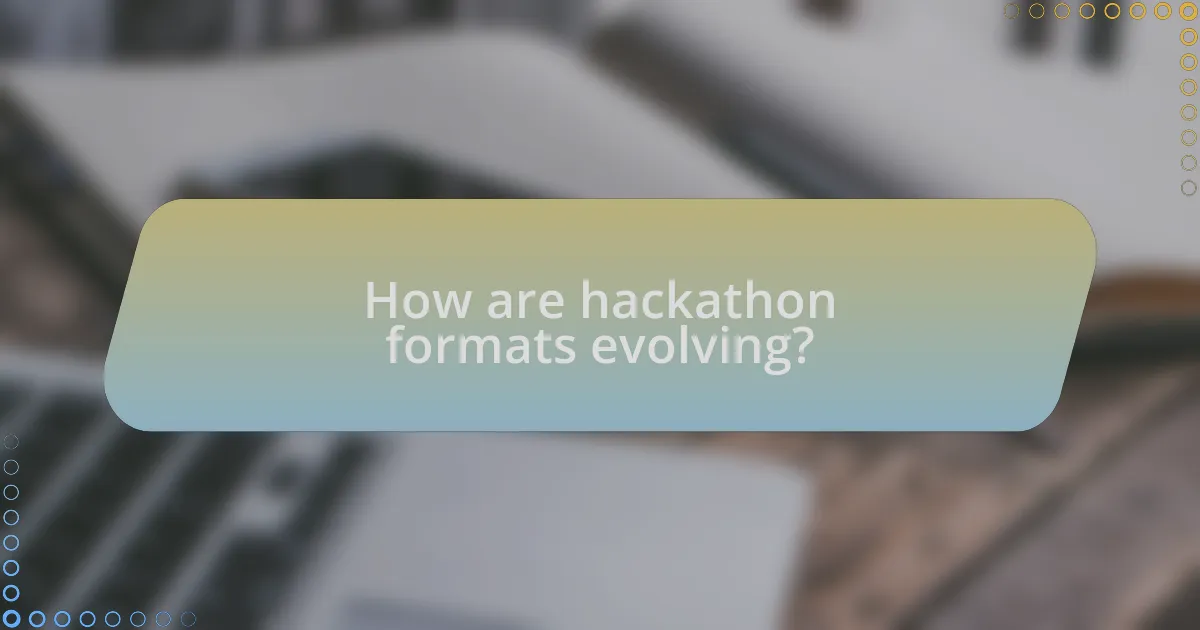
How are hackathon formats evolving?
Hackathon formats are evolving to become more inclusive, flexible, and focused on real-world impact. Traditional 48-hour coding marathons are increasingly being replaced by longer, hybrid events that allow for remote participation and collaboration across diverse teams. For instance, many organizations now host virtual hackathons that span several weeks, enabling participants to engage in deeper problem-solving and innovation. Additionally, there is a growing emphasis on themes such as sustainability and social impact, with events specifically designed to address pressing global challenges. This shift reflects a broader trend in the tech community towards creating solutions that are not only innovative but also socially responsible.
What are the differences between in-person and virtual hackathons?
In-person hackathons involve participants gathering at a physical location to collaborate, while virtual hackathons occur online, allowing participants to connect remotely. In-person events typically foster direct interaction, enabling face-to-face networking and immediate feedback, which can enhance teamwork and creativity. Conversely, virtual hackathons provide greater accessibility, allowing participants from diverse geographical locations to join without travel constraints, thus increasing the potential pool of talent. Additionally, in-person hackathons often include amenities like food and dedicated spaces for brainstorming, while virtual hackathons rely on digital tools for communication and collaboration, such as video conferencing and online coding platforms. These differences highlight the unique advantages and challenges each format presents in fostering innovation and collaboration.
How do virtual hackathons enhance global participation?
Virtual hackathons enhance global participation by removing geographical barriers, allowing individuals from diverse locations to collaborate in real-time. This inclusivity is facilitated by online platforms that enable participants to join from anywhere with internet access, thus attracting a wider range of talent and ideas. For instance, a study by the Global Innovation Index indicates that virtual events can increase participation rates by up to 50% compared to traditional, in-person hackathons, as they appeal to those who may not have the resources or ability to travel. Additionally, virtual hackathons often leverage social media and online communities to promote engagement, further expanding their reach and fostering a global network of innovators.
What challenges do organizers face with hybrid hackathons?
Organizers face several challenges with hybrid hackathons, primarily related to technology integration and participant engagement. Ensuring seamless communication between in-person and remote participants is crucial, as technical issues can disrupt collaboration. Additionally, maintaining equal opportunities for both groups can be difficult; remote participants may feel isolated or less involved. A study by the University of California, Berkeley, highlighted that 70% of remote participants in hybrid events reported feeling less engaged compared to their in-person counterparts. Furthermore, logistical complexities arise in coordinating resources, managing time zones, and providing adequate support for both formats, which can strain organizational capabilities.
What new themes are emerging in hackathon challenges?
New themes emerging in hackathon challenges include sustainability, mental health, and artificial intelligence integration. Sustainability-focused hackathons aim to develop solutions that address climate change and promote eco-friendly practices, reflecting a growing global concern for environmental issues. Mental health themes are gaining traction as participants create applications and platforms to support mental well-being, driven by increased awareness of mental health challenges. Additionally, the integration of artificial intelligence is becoming prevalent, with challenges encouraging the development of AI-driven tools and applications that enhance user experiences and automate processes. These themes are supported by industry trends highlighting the importance of social responsibility and technological advancement in innovation.
How are sustainability and social impact becoming central themes?
Sustainability and social impact are becoming central themes due to increasing awareness of environmental issues and social inequalities. Organizations and individuals are prioritizing sustainable practices and social responsibility, driven by consumer demand for ethical products and services. For instance, a 2021 survey by Nielsen found that 73% of global consumers are willing to change their consumption habits to reduce environmental impact. This shift is evident in hackathons, where participants increasingly focus on developing solutions that address climate change and social challenges, reflecting a broader trend towards integrating sustainability and social impact into innovation and technology development.
What innovative topics are attracting participants in recent hackathons?
Innovative topics attracting participants in recent hackathons include artificial intelligence, blockchain technology, sustainability solutions, and health tech innovations. These areas are gaining traction due to their relevance in addressing current global challenges and technological advancements. For instance, a report from HackerRank indicates that AI and machine learning projects have seen a 30% increase in participation over the last year, reflecting the growing interest in these fields. Additionally, the rise of environmental concerns has led to a surge in hackathons focused on sustainability, with events like the Global Hackathon for Climate Action drawing significant engagement.
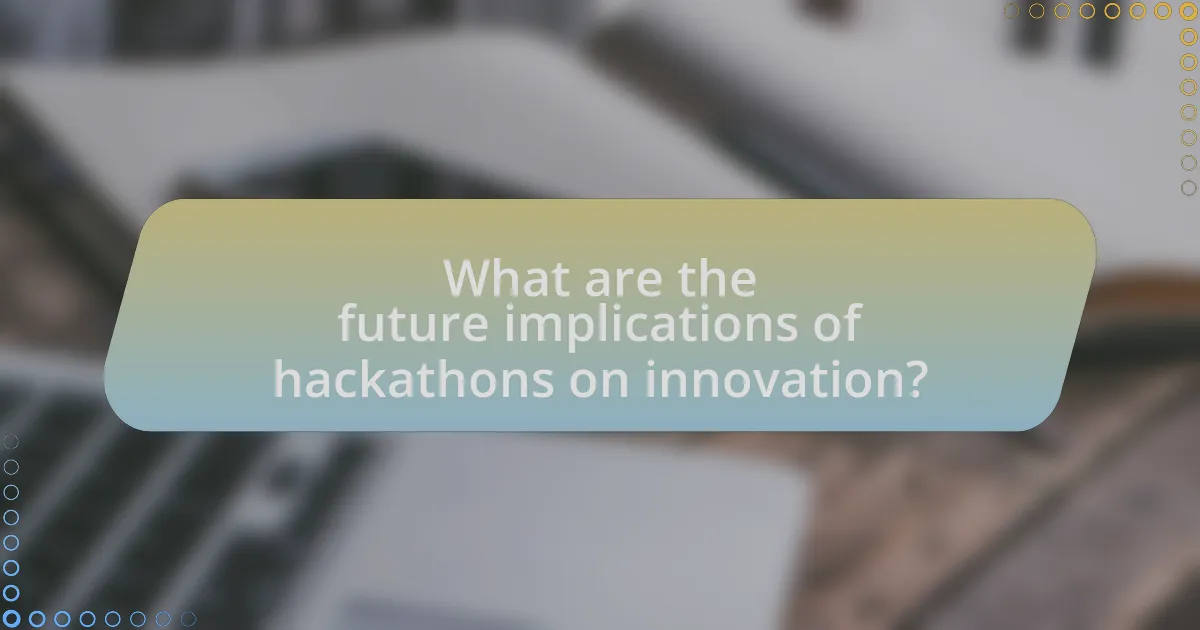
What are the future implications of hackathons on innovation?
Hackathons will increasingly serve as catalysts for innovation by fostering collaboration, accelerating problem-solving, and enhancing skill development among participants. As organizations recognize the value of diverse perspectives, hackathons will likely become integral to corporate innovation strategies, enabling rapid prototyping and the exploration of new ideas. For instance, a study by the Harvard Business Review found that companies that engage in hackathons report a 30% increase in innovative projects and a 20% improvement in employee engagement. This trend indicates that hackathons will not only drive technological advancements but also cultivate a culture of continuous learning and adaptability within organizations.
How do hackathons contribute to startup ecosystems?
Hackathons contribute to startup ecosystems by fostering innovation, collaboration, and rapid prototyping. These events bring together diverse talent, including developers, designers, and entrepreneurs, to solve real-world problems within a limited timeframe, often resulting in viable startup ideas. For instance, a study by the Kauffman Foundation found that 60% of hackathon participants reported pursuing their projects further, leading to the creation of new startups. Additionally, hackathons provide networking opportunities that connect participants with investors, mentors, and industry experts, enhancing the overall support system for emerging businesses.
What success stories have emerged from hackathon participants?
Hackathon participants have achieved notable success stories, including the development of innovative startups and impactful social projects. For instance, the team behind the app “Crisis Text Line,” which provides mental health support via text messaging, originated from a hackathon. This initiative has since facilitated over 5 million conversations, demonstrating the potential of hackathons to catalyze real-world solutions. Additionally, the company “Zocdoc,” which simplifies the process of booking medical appointments, was also born from a hackathon environment, showcasing how these events can lead to significant advancements in various industries. These examples illustrate the transformative power of hackathons in fostering creativity and entrepreneurship.
How do hackathons foster collaboration between startups and corporations?
Hackathons foster collaboration between startups and corporations by creating an environment that encourages innovation and problem-solving through teamwork. During these events, startups gain access to corporate resources, mentorship, and industry insights, while corporations benefit from fresh ideas and agile solutions that startups provide. For example, a study by the Harvard Business Review found that 70% of corporations participating in hackathons reported improved relationships with startups, leading to potential partnerships and investments. This symbiotic relationship enhances the innovation ecosystem, driving growth for both parties involved.
What best practices should organizers follow for successful hackathons?
Organizers should ensure clear objectives and guidelines for successful hackathons. Establishing specific goals helps participants understand the purpose and direction of the event, which can lead to more focused and innovative solutions. Additionally, providing adequate resources, such as mentorship, tools, and technology, enhances the participants’ experience and productivity. Research indicates that hackathons with structured support systems yield higher-quality projects, as participants feel empowered and guided throughout the process. Furthermore, fostering a collaborative and inclusive environment encourages diverse ideas and teamwork, which are crucial for creativity and problem-solving.
How can organizers effectively engage participants before and during the event?
Organizers can effectively engage participants before and during the event by utilizing targeted communication strategies and interactive activities. Before the event, organizers should send personalized invitations and reminders, create engaging social media content, and establish a dedicated online platform for participants to connect and share ideas. During the event, incorporating real-time polls, Q&A sessions, and collaborative workshops fosters active participation. Research indicates that events with interactive elements see a 30% increase in participant satisfaction, highlighting the importance of engagement strategies in enhancing the overall experience.
What strategies can be implemented to ensure post-hackathon follow-up and support?
To ensure effective post-hackathon follow-up and support, organizations should implement structured communication plans, mentorship programs, and resource allocation strategies. Structured communication plans involve sending out surveys to gather feedback from participants, which helps in assessing the event’s impact and areas for improvement. Mentorship programs can connect participants with industry experts who can provide guidance on project development, enhancing the likelihood of project continuation. Resource allocation strategies include providing access to funding opportunities, tools, and platforms that can assist teams in further developing their ideas. These strategies are supported by research indicating that continuous engagement post-event significantly increases the success rate of hackathon projects, as seen in studies conducted by organizations like Techstars and the Global Hackathon Network.
